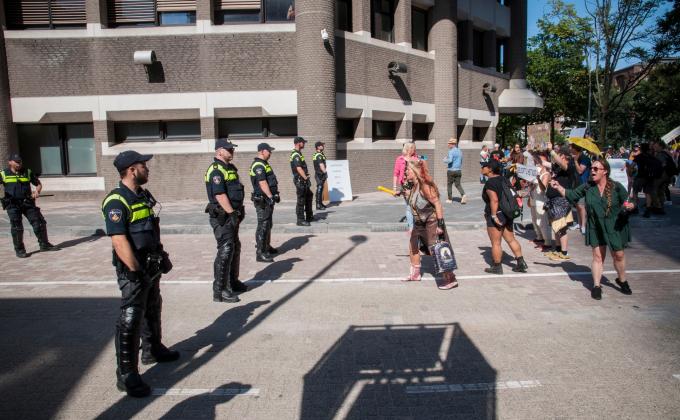Introduction
On 31 May 2024, the well-known anti-Islam activist Michael Stürzenberger was attacked during a demonstration of the Islamophobic group “Pax Europa” (BPE) in Mannheim. Before being shot by the police, the perpetrator stabbed Stürzenberger and four other BPE members multiple times, seriously injuring them, and killed a police officer who tried to intervene. Three days later, Germany’s Federal Prosecutor General (Generalbundesanwalt, or GBA), who is in charge of terrorist-related crimes, announced that he will take over the investigation due to “clear indications” of an Islamist motive. This analysis contextualises the attack by providing background information on Stürzenberger’s and the BPM’s anti-Islam activism, exploring recent trends in Germany’s Islamist milieu and a potential nexus between extremist violence and migration, as well as assessing possible implications for the European election and the risk of further Islamist and far-right radicalisation in Germany.
Michael Stürzenberger and Pax Europa
Michael Stürzenberger is a well-known anti-Islam activist who has been active for years in the far-right milieu, specifically in Bavaria. Amongst other things, he was a speaker at demonstrations of the far-right PEGIDA (Patriotic Europeans Against the Islamisation of the West) movement. Furthermore, he plays a crucial role in the BPE group, where he regularly acts as an organiser and keynote speaker at their demonstrations.
Stürzenberger, as well as the Bavarian BPE chapter, are classified as “Islamophobic extremists” by the German intelligence and accordingly monitored. His Islamophobia is primarily based on the belief that Islam constitutes a totalitarian ideology which poses a fundamental threat to all Western democracies and non-Muslims. He has, for instance, compared the Quran to Hitler’s notorious book “Mein Kampf”. While he pretends to distinguish between religion and a governance system which he calls “political Islam”, he effectively considers nearly all Muslims as Islamists and equates Islam with terrorism. Although Stürzenberger has not openly incited violence, he has been convicted multiple times for extremist-related crimes, including incitement to hatred and the usage of un-constitutional or terrorist symbols, amongst others, for a blog post in which he labelled Islam as a “Fascist ideology” and depicted an image of a man with a swastika armband next to it. He has also long been an outspoken supporter of Israel. Following the attack on the 7th of October and the outbreak of the war in Gaza, Stürzenberger has organised demonstrations under the name “full solidarity with Israel” and blamed Hamas as being solely responsible for civilian casualties while defending Israel’s warfare and calling them “philanthropists”.
Michael Stürzenberger is well-embedded in the German-language far-right online ecosystem and has considerable reach to spread his views. He is a regular writer for the influential far-right extremist online media “PI-News” (Politically Incorrect). Furthermore, Stürzenberger regularly posts (short) videos on different social media platforms, in particular on TikTok and YouTube, where he has a combined number of over 700,000 views. He also skilfully stages his appearances: during his demonstrations, which are usually live-streamed, Stürzenberger employs highly polarising and provoking rhetoric. This often leads to verbal arguments and physical altercations with counter-protesters, which are captured on livestream and spread in separate clips.
Islamism in Germany: TikTokisation and Gaza War as Mobilisation Catalyst
The attack on Stürzenberger must be considered in light of general developments in Germany’s Islamist milieu. Following increasing pressure and crackdowns due to the involvement in and prosecution of some members of the Islamist milieu in Germany for the provision of material and logistical support for terrorist organisations, including the Islamic State (IS), in the 2010s, the milieu has realigned itself. Instead of more physical, provocative activities such as public missionary work and Koran distributions, it has shifted to more covert online activism, especially on TikTok. This shift, which German intelligence authorities have called “TikTokisation of Islamism”, has resulted in a comprehensive network of Islamist channels and videos across different social media platforms.
“Islamist influencers” attempt to appeal to a younger audience by stylising themselves as cool and hip, utilising pop-culture slang, and showing themselves with famous figures such as German rappers. In their online activism, question-and-answer videos play a central role: these videos are based on viewers’ questions in the comment sections, usually concerning how to live in accordance with Islamic rules, which are then answered in 30-40-second clips. Although these clips might appear innocuous at first sight, they convey a rigid and dogmatic Islamist worldview and may serve as a gateway to more extreme views. Previous research indicates that such ‘simplified’ life advice combined with a clear in-group (the Muslim “Ummah”) and out-group (a hostile West) construction can be particularly appealing to youths who experience a period of uncertainty and search for an identity due to a perceived lack of belonging in society. This online activism is usually linked to current political events and developments such as, for instance, the 2023 Quran burnings in Sweden. Since its outbreak, the war in Gaza has become the core topic of Islamist discourses online. Palestinians are mainly portrayed as Muslims who are abandoned or even attacked by a hostile West because of their religion. This distorted portrayal allows Islamists to turn the war into a narrative of an “existential conflict between Muslims and non-Muslims”.
However, in contrast to previous, largely online-based activism, German Islamists were able to turn this momentum into a significant offline mobilisation. Especially the groups “Muslim Interaktive” and “Generation Islam”, both monitored by German intelligence for (ideological) ties to the outlawed Hizb ut-Tahrir movement, were able to organise demonstrations with several thousand participants in different German cities. Although officially announced as protests against the war in Gaza, the main issue of the demonstrations was to criticise media and politicians alike for an allegedly deliberately false and mendacious reporting about the war and a “dictatorship of values” in Germany which would prevent Muslims from living a truthful Islamic life. In April 2024, one of these demonstrations with over 3,500 participants, strictly separated by their gender, made headlines as several protesters were chanting slogans and holding up signs that called for the establishment of a caliphate as the “final solution” for all Muslim struggle. This self-stylised victim narrative of an allegedly suppressive and hostile West can be seen as a reference to the broader “War on Islam” conspiracy theory, which was in the past frequently employed by IS in its propaganda.
While its exact impact is hard to assess yet, this “redesigned” activism seems to make Islamism more appealing, especially to youth. While innocuous at first glance, research demonstrates that such borderline content can serve as a gateway to violent radicalisation, for instance, through the effects of so-called echo chambers and algorithmic amplification, which can gradually lead to more extreme content. While the exact circumstances of the preparator’s radicalisation still warrant investigation, a newspaper was able to identify an alleged YouTube channel of the perpetrator, which contains several Islamist and Jihadist videos.
Far-Right Reactions and Implication for and Beyond the European Elections
The attack was immediately picked up by Germany’s far right. For instance, the AfD’s chairwoman Alice Weidel posted on X (previously Twitter) an image with the phrase “border protection is citizen protection”. Similar statements which used the attack to sweepingly portray migrants and Muslims as a threat were also made by several other AfD politicians. Likewise, a pro-AfD media outlet used the attack to relativise a recent far-right incident of a video showing young, upper-class adults singing racist chants by stating that “a whole nation” condemned them for singing “something wrong” while the real threat of Islamism would be systematically ignored, making German politicians an “accomplice” of violent Islamism.
These first reactions indicate that the far right will try to capitalise on the incident by employing an exacerbated anti-immigrant and anti-Muslim rhetoric. The attack could enable the AfD to put some of their core topics - migration and the threat of (violent) Islamism - into the spotlight shortly before the forthcoming European election. The attack aligns particularly well with the popular German far-right narrative of so-called “Messermänner” (an alleged proneness of migrant men to commit knife crimes). Thereby, the attack may provide an opportunity for the AfD to overcome a trend of declining poll results following several recent scandals such as the disclosure of a secret meeting, where, amongst others, several AfD representatives discussed plans to deport foreigners and Germans with a migrant background, as well as, the far-right collation in the European parliament recently expelling the AfD fraction after statements by the AfD’s top candidate who relativised the crimes of Nazi-Germany’s Schutzstaffel (SS).
A potential aggravation in far-right rhetoric following the attack would be symptomatic of a general rise of far-right extremism in Europe in recent years. Following the so-called “refugee crisis” in 2015, accelerated by the COVID-19 crisis, as well as Russia’s war against Ukraine, increasing numbers of people in Germany have lost faith in democratic institutions and processes and adopted anti-democratic and extremist sentiments. According to the Mitte-Studie, a biennial survey measuring far-right stances in Germany, anti-immigrant sentiments are at the highest level since the first elicitation in 2002.
A Nexus between Terrorism and Migration?
According to media reporting, the perpetrator of the attack against Stürzenberger was a 25-year-old Afghan who arrived in Germany in 2013 as an asylum seeker. Although his application was rejected, he was not deported due to his status as a minor and his later marrying a German woman. Considering that a number of high-profile Islamist attacks, for instance, the recent shooting of two Swedish football fans in Brussels or the 2016 Berlin attack, were conducted by individuals who entered these countries as immigrants or refugee seekers, questions arose about whether there might be a nexus between migration and an increased risk of terrorist attacks. Following the attack on Stürzenberger, this has prompted calls from German politicians to deport rejected asylum seekers and delinquent migrants to countries such as Afghanistan and Syria, which, so far, has not been possible under German law. Calls for pushes towards harder, more restrictive measures after terrorist attacks or high-profile incidents of violent extremism are commonly observed. However, research has produced little evidence that increased migration (flows) are related to an increased risk of (Islamist) terrorist attacks. Instead, a policy of deporting to countries such as Afghanistan or Syria likely contradicts international human rights law, especially the non-refoulement principle, thereby undermining Germany’s commitment to the rule of law.
Risk of a Cumulative Radicalisation?
The trends described above result in a highly polarised German society. On the one hand, far-right sentiments, particularly hostility towards immigrants and Muslims, are higher than ever before in the last two decades. On the other hand, there is a highly active Islamist milieu which, in light of the war in Gaza, displays a high level of emotion. Since, as expressed by Chancellor Scholz, Israel’s security is part of Germany’s Staatsräson (reason of state), German politicians have generally been hesitant to criticise Israel for its warfare in Gaza. However, this has led to a perception in some parts of the population, especially amongst Muslims, that every legitimate criticism of Israel’s warfare is generally dismissed as antisemitism, which has enabled Islamists from the fringe to position themselves as the only valid alternative.
Taking into account this polarised climate and, mainly, that the attack was carried out directly by an Islamist against a prominent far-right figure, the risk of “cumulative radicalisation” looms large. According to this concept, two opposing ideologies, in this case, far-right and Islamist extremism, have the potential to fuel each other, resulting in an escalating spiral of violence. Previous research has demonstrated that experiences of racism, discrimination, and exclusion can contribute to individuals’ radicalisation. Authorities currently assume that the perpetrator attacked Stürzenberger to “silence” his Islam criticism. Moreover, while this attack seemed not to be directly related, German security authorities have foiled multiple terrorist plots inspired by the war in Gaza in the last few months.
In return, research has demonstrated that Islamist violence can lead to aggravated far-right rhetoric, especially online, which subsequently may increase far-right attacks against Muslims and immigrants. Vice versa, an increase in far-right attacks and displayed racism may trigger further Islamist attacks. Although a causal link is hard to prove, a similar dynamic could be observed in the years 2015 and2016, where an increase in IS-related attacks was accompanied by a stark increase in far-right attacks in Germany. The seriousness of this threat also manifests in the recently published number of annual politically motivated crimes, which is on an all-time high, with both right-wing and Islamist extremist-related crimes having risen by more than 25 percent , in particular since the outbreak of the war in Gaza.
Conclusion
The Mannheim knife attack is only the most recent manifestation of a highly active and emotionalised Islamist milieu in Germany and highlights its high potential for violence. The reluctance of German politicians and the perception of some parts of the population of not being able to voice legitimate criticism against Israel has enabled Islamists from the societal fringe to position themselves as the only valid alternative to the political mainstream. Thereby, Islamists are able to appeal to, and mobilise a considerable number of (new) supporters. This bears the risk of a “mainstreaming” of Islamist ideology, which can already be observed for a while in the online sphere. At the same time, far-right extremist sentiments are on the rise in Germany, with a continuously radicalising AfD as its most visible representative. The first reaction of the milieu to the attack indicates a further aggravation in far-right rhetoric. While its exact impact on the European elections remains to be seen, the attack highlights the necessity for two general policy actions to avoid further societal polarisation and prevent the risk of further violence and the potential for cumulative radicalisation.
First, there is an urgent need for a more nuanced dialogue regarding the war in Gaza. German authorities should invest in strategic communication to vividly outline and justify current political positions. Furthermore, civil society organisations which foster mutual exchange should be supported, and “safe spaces” where individuals can voice legitimate concerns should be established. At the same time, clear lines need to be drawn between legitimate criticism against Israel and antisemitic hatred to ensure that Israeli and Jewish citizens do not live in a climate of fear and are not held accountable for the politics of the Israeli government. This avoids the formation of a societal vacuum that can be exploited by Islamists.
Second, security and P/CVE authorities should take the current rise in Islamist and far-right extremism seriously and take corresponding actions. This should include “hard” measures by German security authorities, such as the ban on Hamas and its supportive structures or the recent classification of the AfD as a far-right extremist suspected case. However, such complex measures should be carefully considered, especially concerning a more restrictive asylum policy based on an unproven nexus between extremist violence and migration. Moreover, such measures should be based on a holistic approach that also aims at prevention rather than the mere countering of (violent) extremism. A specific focus should be on extremists’ tactics that appeal to youths, especially in the online sphere. Recently, TikTok has proven to be a main medium for both far-right and Islamist extremists to reach younger audiences and convey their messages through subtle content that conceals its actual extremist nature. Consequently, it is important to strengthen the media literacy of younger people and warn against such content.








